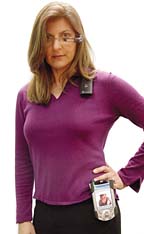“I want to see the proposed equipment operate under real-life conditions,†Ricky Bryant of NIBCO, Elkhart, Ind., says. Bryant, who recommends security equipment for 17 locations, works through national account programs, but also with local dealers. “I like to work with dealers who really know the equipment, the specifications and my needs and not just how to install,†he says.

The Price Factor
Price and portability of specialty video also are important elements.David Cammock, who heads a security operation for a chain of healthcare facilities in California, Oregon and Washington, shops for price but “price comparisons must be based on a firm set of features so that I am not comparing apples to oranges.†Cammock sees portability of specialty video as growingly essential.
“Locations and facilities change more often today. Providing a safe and secure working environment is always a given but some incidents and threats are short-term in nature and I value video solutions that I can set-up and knock-down easily.â€
Wishing to remain anonymous, a security executive who works for an Ohio-based manufacturing organization says he prefers to work with specialty sources for specialty video, such as covert equipment. “That knowledge base is important to me. My dealer knows the equipment, but he also knows the law and the effectiveness of covert cameras. They come in various packages and some are more effective than others.â€
What customers want in specialty video depends on an end-user’s security needs, of course; but unlike traditional video security and electronic access systems, specialty video buyers search for and stay with dealers with specific expertise in the products.
Surveying End-user Factors
In February,SDMconducted an online survey of end-user buyers on specialty video. The survey sought purchasing triggers, dealer relationships, tips and hints.Of those respondents who say they use specialty video, many have covert cameras and have purchased cameras and domes based on certain aesthetics, gear that blends well with a facility’s surroundings. Covert equipment and aesthetics are at the top of the shopping list this year, too. There also is strong interest in video gear that is portable and can be easily moved inside a facility.
“Digital is the way to go. Video for mobile operations also is significant in our current purchasing plans,†the Ohio security executive reveals in a follow-up interview to the online SDM survey. “Fixed [video] systems can hinder by ever-changing program.†This buyer says he compares equipment by price but “I look at the specs first.â€
Bryant, with more than 20 years in the business, considers price but often sees equal worth in actual tests of specialty video under actual working conditions. “You can get the specifications for lowest light operation but what do the images look like, what are the results? Are the people just silhouettes or is there enough clear information in the pictures for identification purposes? An integrator or dealer that proves that to me is the person I want in a long-term business relationship.â€
Several respondents to the SDM “What Customers Want†survey agreed that they try hard to avoid aftermarket buyers for specialty video. “Buy specialty video as a turnkey solution,†Cammock says. Bryant agrees: “Do it without a lot of enhancements.†Specialty video to him doesn’t mean specially built.
Sidebar
What Customers Want: Purchasing Factors Vary
Most important factors: Reliability of specialty video 16%
High-quality video images 14%
Price 13%
Ability to tie into existing gear 11%
Fast, easy installation 11%
Discreet installation 9%
Vandal resistance 9%
Self-contained power supply 6%
Aesthetics 6%
Brand name 4%
When push comes to shove, top two factors:
Reliability
High-quality video images
Source: SDM, “What Customers Want†survey, based on online responses of end-user buyers as represented by SECURITY Magazine subscribers, February 2004
Sidebar
‘Take My Advice’
Here are some tips from end-user buyers of specialty video:• Demo the equipment in a real-life situation.
• Ask the dealer or systems integrator to explain in detail the
differences between choices.
• Spend more time on the front end – specifications,
feature sets, brochures.
‘Don’t Make My Mistake’
• Convince top management of equipment need,
especially covert gear.
• Avoid the “John Doe†dealers; seek out specialists.
• Compatibility is more than a word; make the seller prove it.
Sidebar
What Customers Want:
Purchasing Plans for Next 12 MonthsOf those planning to purchase:
Covert Video 20%
Aesthetic video 17%
Portable video indoors 14%
Infrared 14%
Portable video outdoors 10%
Source: SDM, “What Customers Want†survey, based on online responses of end-user buyers as represented by SECURITY Magazine subscribers, February 2004
Sidebar
Top Reasons Customers Purchase Specialty Video
• They need to enhance their existing surveillance systems.• They have a specific security problem that will be
solved with a temporary install.
• Aesthetics and corporate culture dictate special purchases.